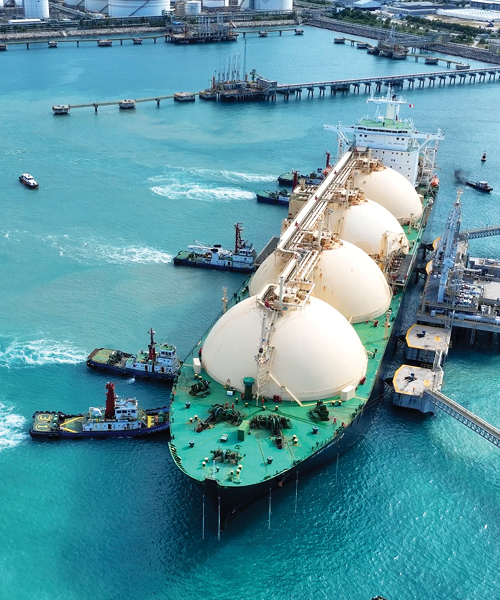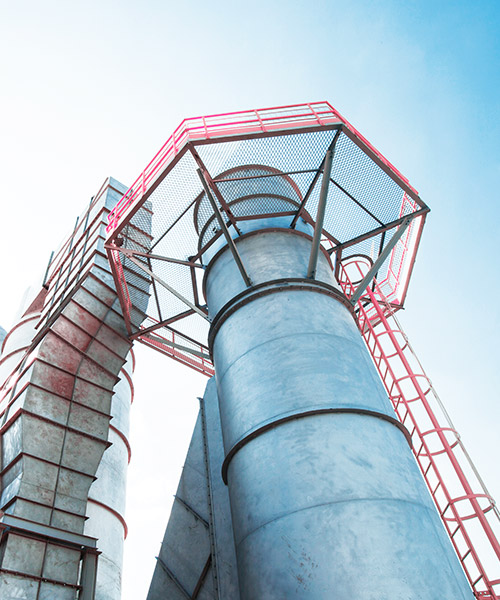August 15, 2024 • 4 min read
LNG production: How to run facilities more efficiently and sustainably
Staying profitable. Reducing CO2 and methane emissions. Providing energy security. How can LNG producers succeed in this complex environment?
Did you know that liquid natural gas (LNG) production is projected to grow by 25 percent to 500 million tons annually over the next five years. Mostly by new capacity currently being built in North America and Middle East.
However, LNG producers are facing shifts in demand due to the global energy security crisis, the growing prospect of carbon taxes, and pressure to meet production and profitability targets.
So, how can producers make their facilities more reliable, and build more robust business models that align with decarbonization targets?
Adopting new technologies to improve plant reliability
“There has been a large increase in LNG capacity over the last decade, particularly in North America,” says Andy Loose, Group Vice President, LNG. “Many of these new LNG plants are being run by first-time operators, whose main priority is to ensure facilities run reliably and earn a return on invested capital.
“But just because these plants are new, doesn’t mean they are going operate smoothly – or sustainably – from the beginning.”
Once LNG facilities are operating, maintaining or modifying them can involve thousands of activities. This creates the risk of unplanned outages or less efficient operation. However, digitalization and automation technologies can help minimize this.
“Producers can use a digital twin to create a single, reliable source of information to replicate their real facility,” says Loose.
“By feeding real-time data into this model, all project stakeholders can see how equipment is performing, where the bottlenecks are. And also test the impacts of future modifications without actually disrupting the real facility. This supports better decision making.
“We also work with LNG producers to implement technologies that process large volumes of data, to predict when equipment needs maintenance, before a failure occurs,” continues Loose. “This informs the timeline for future modifications, so producers can plan projects and turnarounds with certainty.”
Loose appreciates the challenge for some producers is selecting and implementing technologies to meet their objectives. And then trusting these technologies to inform maintenance activities.
It can feel like a leap of faith, our role is to turn this into a confident step. Especially if producers depend on older systems or technologies to manage their operations. But it’s an investment that will repay itself many times over the life of the facility.
Finding the right LNG expertise
LNG producers need to keep their core teams lean and efficient during routine operations, to remain profitable. But when the time comes for major planned maintenance or upgrades, the challenge is sourcing the right expertise to support these activities.
“The demand for LNG expertise is now high in North America with the large number of new facilities and new projects,” says Loose. “We support customers on their maintenance or upgrade projects with our larger resource pool so producers don’t have to spend time and money to find and mobilize new teams each time.
“This human capability is even more important when unforeseen issues arise,” Loose adds. “Even new facilities can fall idle for days, weeks or even months. This is an unfortunate reality for many first-time LNG producers who can least afford it. So, they need to get back up and running as quickly as possible to stay competitive.
“LNG producers need to have an in-depth understanding of their facility to minimize downtime. Or they need to work with a partner that can provide experts in operations, maintenance, and turnaround planning and execution, whenever they need it. That can be the difference between a week of downtime, and months of downtime.”
Differentiating LNG in a decarbonizing world
LNG producers need to reduce CO2 emissions from their facilities as soon as possible, whether the impetus to decarbonize comes from mandates, carbon taxes or shareholder pressure.
According to Loose, producers that successfully execute decarbonization projects will gain market share over time, increase their profitability, and guarantee their social license to operate.
“We support our customers to explore the range of decarbonization pathways available,” he says. “This can be anything from conducting simple energy optimization studies to making brownfield modifications such as upgrading compressors, gas turbines and other main equipment from gas powered to electric ones powered by renewable energy or other sustainable power sources.
“We also deliver more complex decarbonization initiatives, such as pre-combustion capture of CO2 from feed gas. Or post-combustion capture of CO2 from flue gas streams of gas turbines and turbine generators.
“These ambitious projects are becoming more appealing, thanks to decarbonization mandates, the desirability of lower carbon LNG in the market, and impacts of the Inflation Reduction Act in the US.”
The future will reward proactive producers
The LNG market will change significantly over the coming decades. But Loose believes there are many pathways for producers to succeed in a decarbonizing world.
“The world will need LNG for many years with peak consumption not expected until the 2040s in many countries. And especially for situations where new energy technologies aren’t yet viable around the clock. But future LNG production needs to have a much lower CO2 and methane footprint. This is a big opportunity for producers that can keep their plants running profitability – with lower greenhouse gas emissions – for long periods of time.
“Maintenance and modifications are a normal part of operations,” says Loose. “They may add some additional expense and downtime in the short term. But executing decarbonization initiatives, embracing digital technologies to improve facilities, and finding the right experts for projects, will position producers for success in this challenging environment.”
Editor’s Note, August 2025: This article was written by Andy Loose, who has since passed away. We honor his memory and maintain this piece in recognition of the contributions he made through his work.




